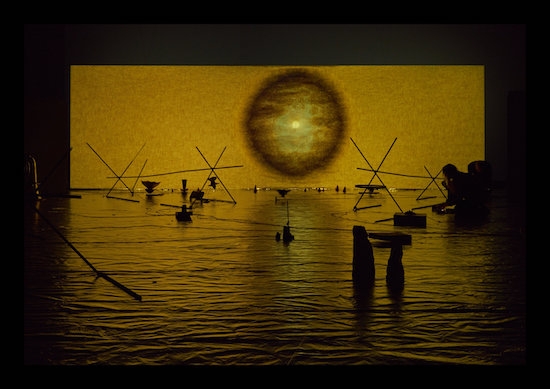In November 2016, the Norwegian artist collective Verdensteatret retraced their steps along the Mekong Delta in Vietnam, a location they had first visited ten years ago, to begin research on a new work: HANNAH. A hybrid between live music performance, experimental theatre and installation, the piece is routinely described in the Sonic Acts marketing material as described as ‘immersive’, a ‘spatial composition’ and a ‘polyphonic audiovisual instrument’ yet Verdensteatret refute all allegations of interpretation surrounding the piece.
So, let’s begin with pure description. HANNAH takes place in a very generous white space, which frames a tin foil covered floor. Scattered across the room are unidentified electronic gadgets. There is a persistent hum of gnawing energy, of tangible anticipation, a prelude to ecstasy. A hirsute individual appears with a chair, carrying it to the centre of the room and proceeds to sit down and create simple percussive movements with two wooden blocks. His breathing is amplified, his exhalations punctuate the white space and he repeats these motions a number of times across marginally different locations. A video begins to play which may graphically resemble the building up of machinery noise, the electrical hum becoming an ecstatic roar. The video graphs appear to peel and tear across the entire space, shredding everything in its way, sound tracked by an electronic feedback system, resisting chaos by generating chaos.
These are merely the opening acts of HANNAH. And it’s nigh on impossible to truly resist interpretation because the entirely of the piece is so alive to any form of critique, prodding and provoking you into some form of reaction because you feel somehow responsible for what’s happening, you feel part of the tectonic shifts generated by this collision of noise and amplified time-spans. And just as you are becoming accustomed to the discordant surroundings, these dissolutions demand and instigate another image, which, on screen, is the façade of a building in Saigon, appearing towards the end of the piece as a contrary texture in that it is seemingly solid, a strangely aberrant amalgam of the urban and the corporeal, the filmic and the photographic.
Of course, all this talk of dissolve and dissonance might give you the impression that HANNAH is a resolutely wounded and damaged piece, emotionally ossifying in its volatile intensity. But this is not the case. HANNAH spectacularly dovetails between rupture and rapture and somehow manages to be about everything.
Asle Nilsen, one of the founding members of the group, remarked to me “when I watch the piece myself, I see all these visible references to art history and things that have been done over the last 150 or 200 years. While making the piece we are discussing a lot, naming things, naming all the objects and the scenes and our language is in the past sense and we are trying to describe what is between us and what has happened. We try not to pin it down, to keep it open but we need naming conventions to make it efficient. We share a common view that we know nothing about the future.”
Perhaps this explains why the collective are so opposed to overt interpretation. Even the title of the piece has no literal connection to the performance, as HANNAH was simply a practical name used to refer to the performance during its construction. But it stuck and like all naming devices, the object has grown with the name. The name’s palindromic structure suits the performance, defying linear time by looking both forwards and backwards and these contradictions, in marking out the collapsings and absences at the heart of our concept of history, impel the images and sounds of HANNAH. Each element of the performance is part of a chain or sequence that accumulates voids in space and these elements and their compulsive obliteration form an intoxicating charge within the conception of the performance.
But HANNAH does tell a very clear story: a story of artistic labour, of research, development and performance intertwined in an egalitarian setting. The piece dissolves hierarchies: everything is visible, everything is played live, there is a blatant equality of labour which feels curiously nostalgic. We see the performers communicating across artistic disciplines, in a medium in flux between theatre, sound art and visual art and in which these collisions of genre generate entirely new surfaces; geography stripped to the bone, compacted to their raw anatomical or architectural components.
And in coming to all these tentative conclusions, I’m guilty of committing the crime that Verdensteatret precisely did not want to happen. On meeting the collective after the show, they appeared quietly hopeful that the performance would mystify rather than becoming demystified through analysis. Both Nilsen and fellow performer Janne Kruse would only admit to the piece being ‘abstract’; the latter did later opine that it may be about the construction of memory and how memory fades away. In fact, it might be best just to say that Verdensteatret’s HANNAH is an astonishing performance piece which performs a dramatic excavation, one that rigorously scours all vitally excessive and contaminated surfaces, until only the primary gestures of the eye remain.
HANNAH will be playing at Tramway on Thursday 7th November as part of Sonica Glasgow. Sonica Glasgow runs 31 October to 10 November


